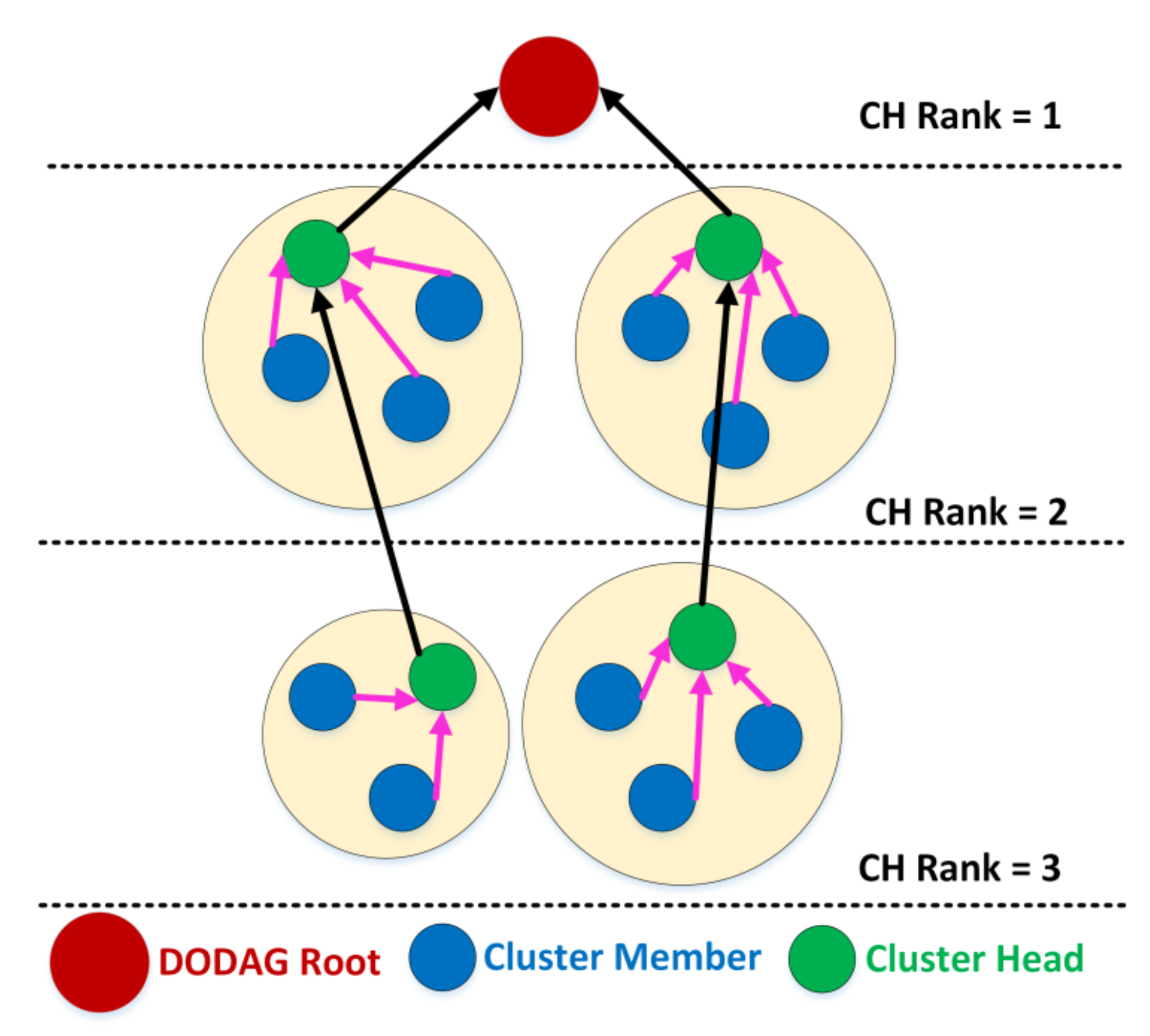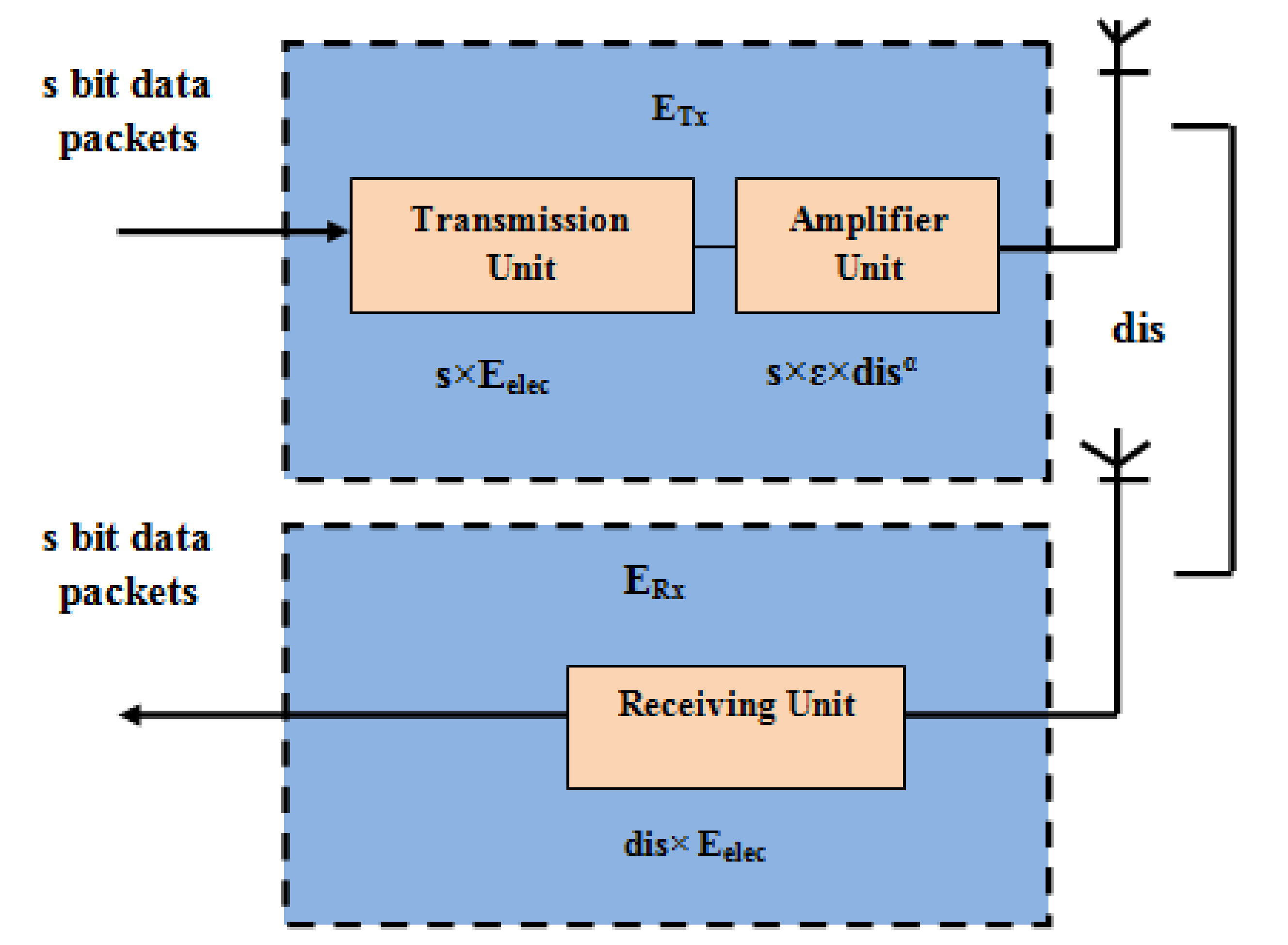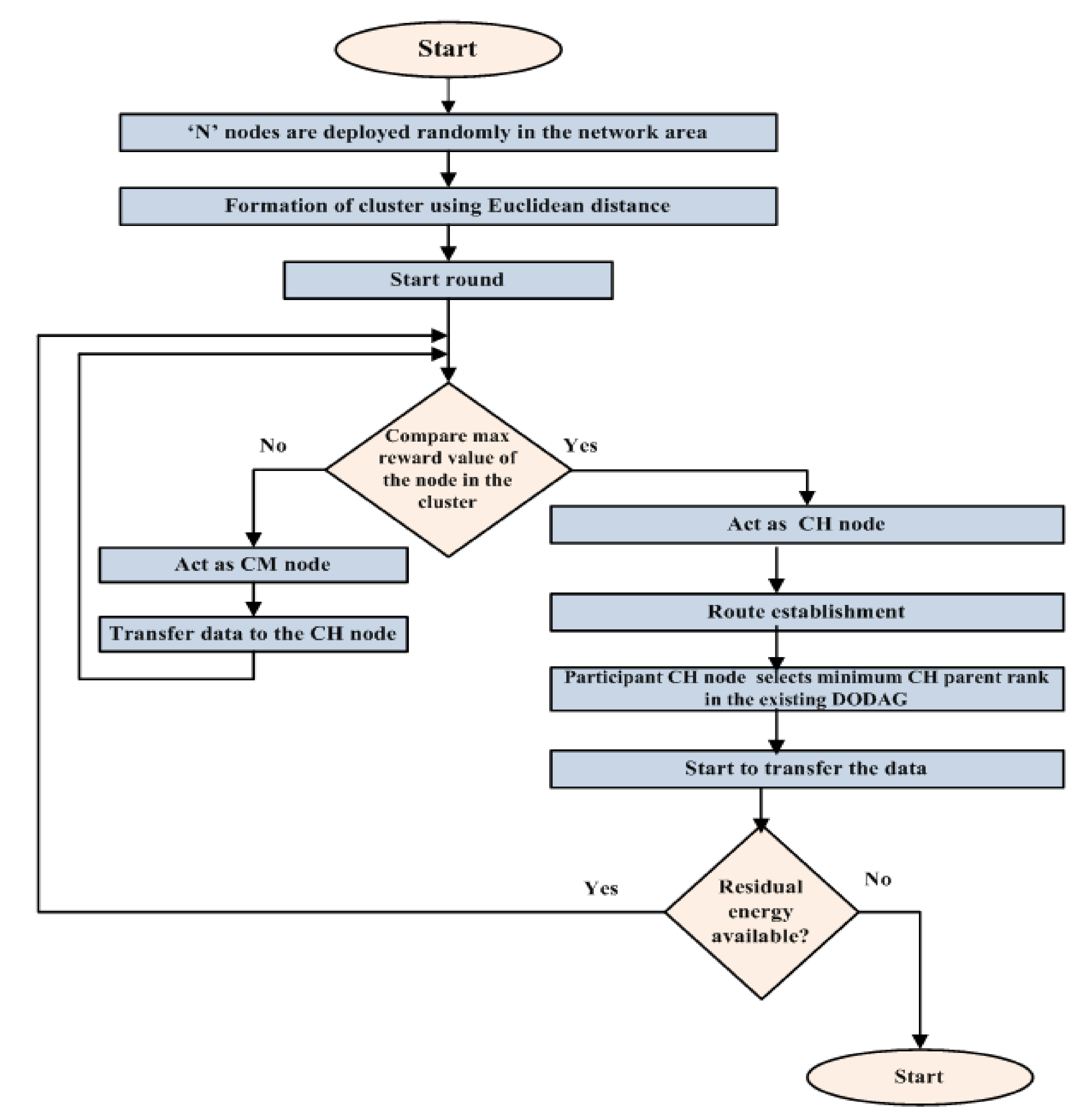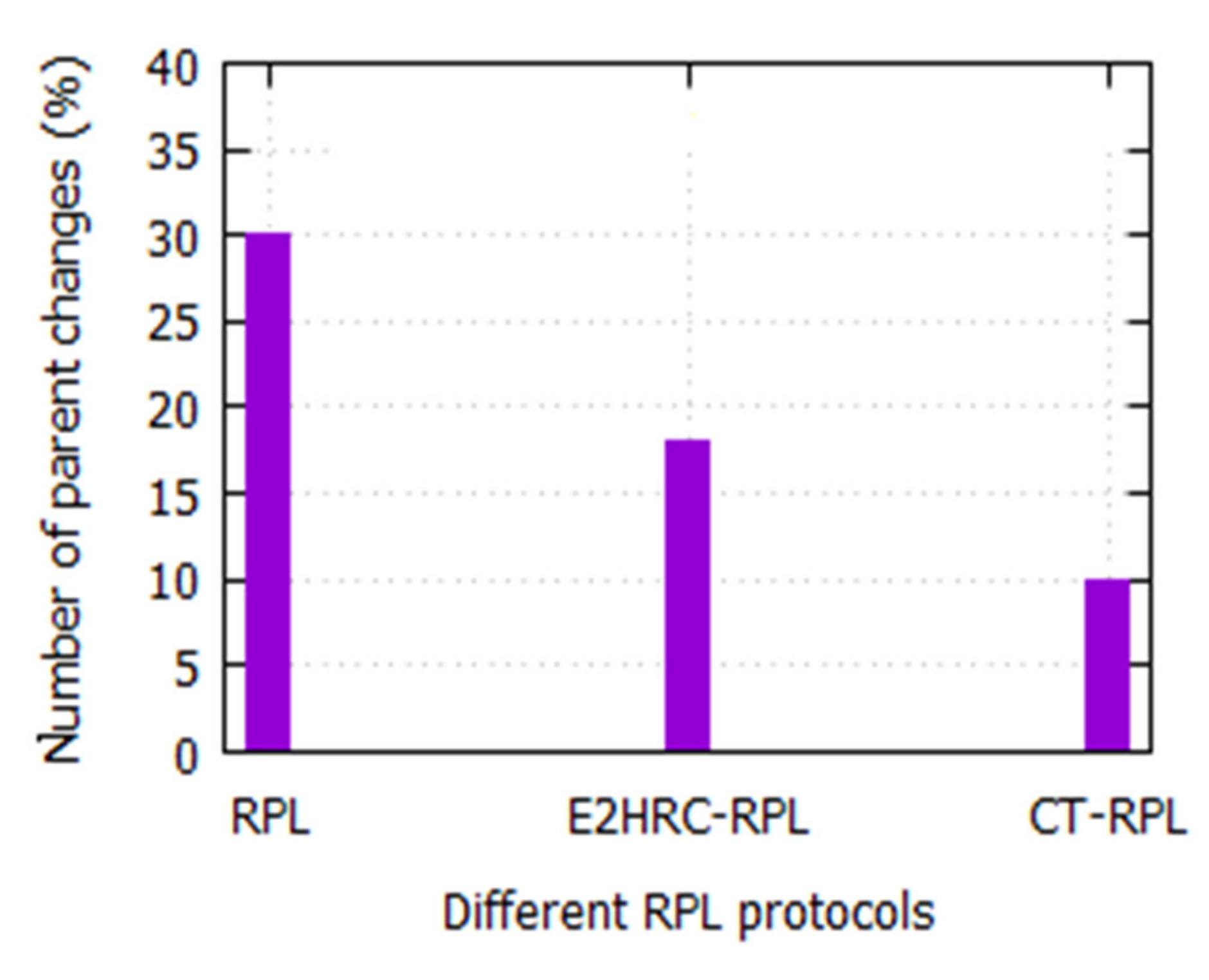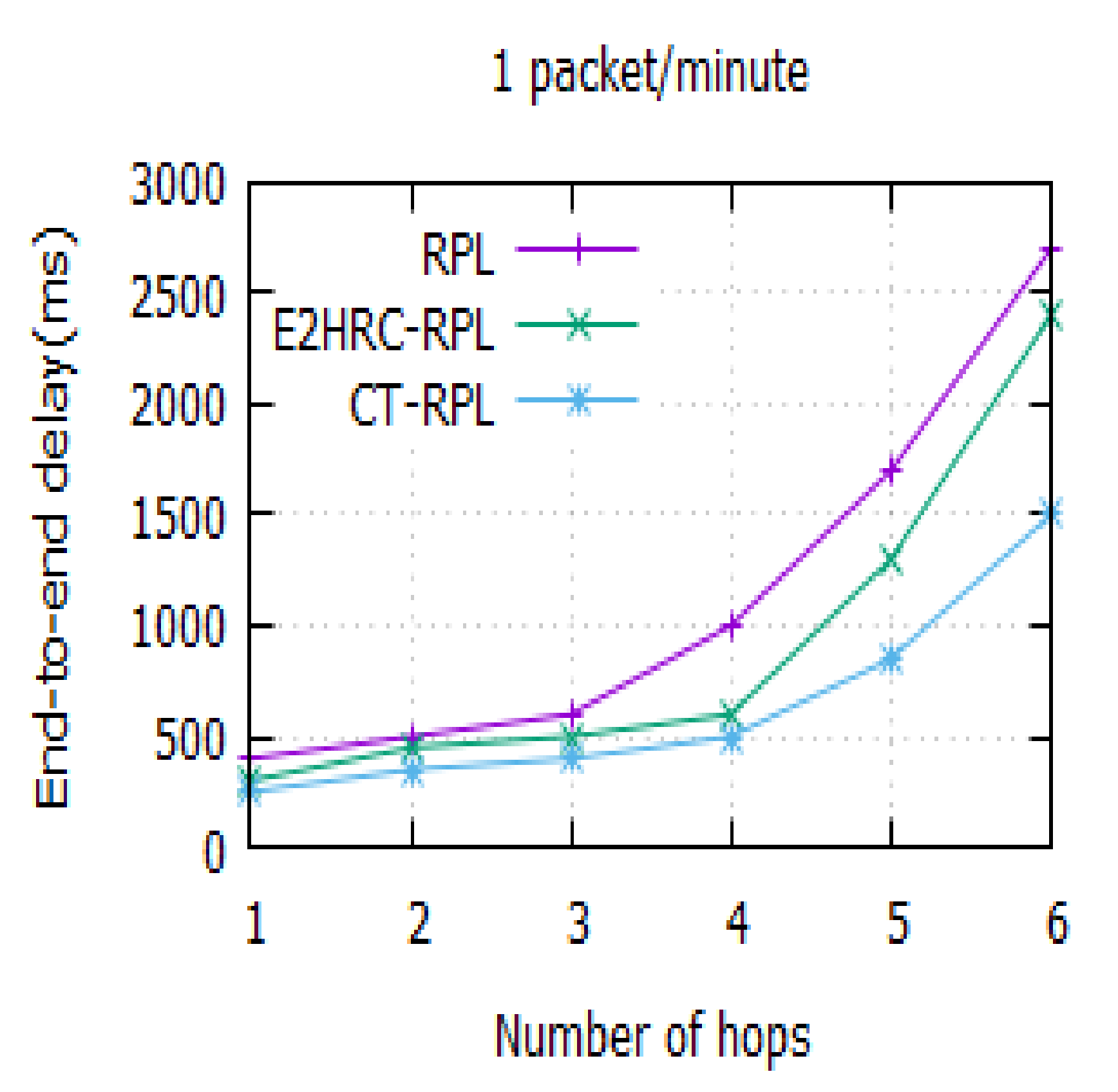This section discusses various cluster-based routing protocols that can be used by the Internet of Things to increase the lifespan of the network.
Zhang et al. [
37] proposed an energy-efficient heterogeneous ring cluster routing (E2HRC) protocol in WSNs, where a ring clustering is performed with event-driven CH rotation principle-based cluster head selection. However, E2HRC-RPL initially takes more time to form the clusters in the network. Conti et al. [
38] created a set of RPL, resulting in the extension of the packet delivery ratio by 25%, increasing the scalability and data communication by reducing the latency and packet loss in IoT networks. On the other hand, this creates node congestion for unbalanced clusters in the network. A content-centric RPL (CCR-RPL) was proposed by Jin et al. [
39] that reduced the data traffic across the network, using a higher data aggregation ratio in the routing process. Even though their proposed protocol outperformed the standard RPL in terms of latency and packet delivery ratio, it supported limited content being highly resource-constrained in the nodes.
Xu et al. [
40] proposed an energy-efficient region source routing (ER-SR) protocol for WSN. The protocol distributed the energy utilization among the nodes to increase the lifespan while overcoming the limitations of resource constrain. ER-SR offered a substantial performance with respect to the energy efficiency, lifespan, and latency as compared to other RPL in WSN, but it required extra time for picking up a suitable parent for selecting CH in the cluster. Zhao et al. [
41] proposed an energy-efficient region-based RPL (ER-RPL) for LLN. The protocol improved the latency and energy consumption but faced node congestion due to uneven region formation. A hierarchical-distributed management clustering (HDMC) protocol for WSN was designed by Shahraki [
42] that surpassed the performance of LEACH and hierarchical-distributed management clustering (HEED) in terms of latency and lifetime. The model had limited applications, unlike the previously mentioned protocols. An adaptive distributed game theory-based congestion control in RPL for WSN was proposed by Ramesh and Priya [
43] to solve the congestion issue of RPL. The protocol supported both congestion detection and moderation during the route establishment, increasing the network lifespan and decreasing the latency. However, the threshold value was not well-defined for the protocol. Lin and Wang [
44] proposed an energy-efficient clustering protocol using dual cluster head and game theory (ECGD) in WSN. The protocol’s effectiveness was compared to LEACH-ERE, threshold-sensitive energy-efficient sensor network (TEEN), and power-efficient gathering in sensor information systems (PEGASIS). The ECGD protocol achieved superior performance through the network’s energy and lifespan of the network. Sohail et al. [
45] proposed a game theoretic approach for power management (GTSPM) in the IoT. The selection of CH played an important part in the IoT network. It considered the game theoretical approach for selecting the cluster’s appropriate CH nodes. The effectiveness of GTSPM was compared with the LEACH and game theory-based energy-efficient clustering (GEEC) routing protocol. However, it provided less reliability compared to other protocols. Verma et al. [
46] proposed two novel algorithms, namely the genetic algorithm-based optimized clustering (GAOC) protocol and data sink-based GAOC (MS-GAOC), for electing the CH node in WSN. It addressed the hotspot problem in the network. The GAOC protocol was compared with the dynamic cluster head selection based on the genetic algorithm (DCH-GA), genetic algorithm-based distance-aware LEACH (GADA-LEACH), and threshold-sensitive energy-efficient delay-aware routing protocol (TEDRP). Additionally, the MS-GAOC protocol was compared with the multiple data sink-based dynamic clustering of heterogeneous wireless sensor networks, based on a GA (MS-DCHGA), multiple data sink-based threshold-sensitive energy-efficient delay-aware routing protocol (MS-TEDRP), and multiple data sink-based genetic algorithm-based distance-aware routing (MS-GADA) protocol. However, its CH selection was inefficient due to the distributed approach of CH selection and haul transmission. Verma et al. [
47] proposed two protocols, namely the multiple data sink-based energy-efficient cluster routing (MEEC) protocol and improved dual hop routing (IDHR) protocol, for electing the optimal CH selection in WSN. It concentrated mainly on the network longevity and network hotspot problem. The efficacy of the IDHR protocol was compared with the threshold-sensitive energy-efficient delay-aware routing protocol (TEDRP), stable energy-efficient clustering protocol (SEECP), and distance-based residual energy-efficient stable election protocol (DRESEP). The performance of the MEEC was also compared with the IDHR. Thus, it prolonged the network lifetime. However, the energy depletion increased due to the systematic rotation of the relay nodes and increased the consequently depleted energy. A novel routing architecture designed for harsh environment monitoring was proposed by Verma [
48]. The objective of this work was to prolong the lifespan by addressing the hotspot problem in the network. The intra-cluster routing was improved by adopting node density factor in CH selection. Thus, it effectively extended the network as compared to the stable and energy-efficient clustering protocol (SEECP). However, other radio interferences were not considered in this work. Quality of Service (QoS) provisioning-based routing protocols using multiple data sinks in the IoT were proposed by Verma [
49]. The cluster head (CH) selection was optimized by adopting the metrics, distance, node density, remaining energy, and energy threshold factors. The simulation results confirmed that the proposed protocol outperformed the state of the standard protocols. However, it was not suitable for large area networks. Verma et al. [
50] also investigated various hierarchical routing protocols in WSN. They discussed the versatile routing protocols and their advantages and limitations. A new neuro fuzzy-based cluster formation protocol (FBCFP) for WSN-based IoT was proposed by Thangaramya [
51]. The effectiveness of FBCFP was compared with LEACH and HEED. It demonstrated better performance by means of energy utilization, end-to-end delay, and lifespan of the network. Munisamy et al. [
52] proposed virtual force-based intelligent clustering for energy-efficient routing (VFICEER) in WSN. The advantage of VFICEER increased the network lifetime and packet delivery ratio. Moreover, it reduced the delay and energy consumption. However, the energy consumption was high due to the ad-hoc nature of this network. Turgut [
53] proposed a distributed clustering with decreased uncovered nodes (DiCDU) to resolve the uncovered node problem after the election of cluster heads. Thus, it extended the lifetime of the network. Dao et al. [
54] proposed a new approach of aggregating data in CHs for improving the classification of support vector machines (SVM) with a flower pollination algorithm (IFPA) to achieve classification accuracy. The IFPA-SVM algorithm forwarded a number of data, which was high when compared to the SVM and hidden Markov model (HMM). However, the CH node in IFPA-SVM consumed more energy than the other algorithms. In the related works, various cluster-based RPL protocols, clustering protocols, and CH selection were discussed using a game theoretic approach.
The following are the limitations of the cluster-based RPL protocol: (i) it takes more time to form the clusters in the network, (ii) it results in network congestion and unbalanced energy among the nodes in the clusters, and (iii) it takes time to select the cluster parent in the network. It is further observed that the clustering protocol is suitable for specific applications, such as temperature monitoring and light event detection. Although researchers have proposed various techniques such as probability basis, fuzzy logic, and residual energy to optimize the energy utilization among the nodes in the cluster, nonetheless, there is still a gap in the literature that focuses on prolonging the network’s lifespan while balancing the energy utilization among the cluster nodes. Keeping all these existing works in consideration, the objective of this paper is to prolong the lifespan of the network. This paper proposes a cluster-tree-based routing protocol (CT-RPL) that performs cluster formation process, cluster head selection, and the route establishment process in order to increase the lifespan of the network.
